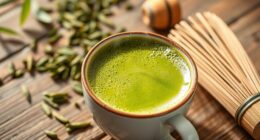I’ve always enjoyed herbal teas, yet turmeric tea holds a special place in my heart. Its wonderfully spicy taste is not the only thing that draws me to it; the myriad of health advantages it offers also makes it an essential part of my daily regimen.
In this article, I will share with you how to make turmeric tea using ground turmeric and provide tips for getting the most out of your cup. Turmeric has been used in traditional medicine for centuries due to its anti-inflammatory and antioxidant properties. It has been shown to improve brain function, lower the risk of heart disease, and even potentially prevent cancer.
And while turmeric can be added to many dishes as a spice, drinking it as a tea allows your body to absorb its active compounds more effectively. So without further ado, let’s dive into the world of turmeric tea and learn how to brew up the perfect cup!
Key Takeaways
- Turmeric tea has numerous health benefits, including anti-inflammatory and antioxidant properties, improved brain function, reduced risk of heart disease, improved digestion, and improved joint and skin health.
- To make turmeric tea, you will need a small pot, whisk or spoon, fine mesh strainer, measuring cups and spoons, ground turmeric, water, honey or other sweetener, and fresh ginger (optional). It is recommended to add black pepper to increase bioavailability and adjust the recipe based on personal taste preferences.
- It is important to source high-quality, ethically sourced turmeric powder from brands that prioritize sustainability and ethical farming practices. Small businesses or local farmers should also be considered.
- Turmeric can also be incorporated into scrambled eggs, golden milk, and rice dishes. However, excessive consumption can lead to gastrointestinal issues or allergic reactions, and may interact with certain medications, so it is important to talk to a doctor before incorporating into the diet.
The Health Benefits of Turmeric Tea
You may be surprised to know that drinking turmeric tea can provide a plethora of health benefits. These include reducing inflammation, improving brain function, and lowering the risk of heart disease. Turmeric is a spice that contains curcumin, a powerful antioxidant with anti-inflammatory properties. It has been used for centuries in Ayurvedic medicine to treat various ailments.
Research has shown that turmeric supplements can help reduce inflammation in conditions such as osteoarthritis and rheumatoid arthritis. Drinking turmeric tea regularly can also improve brain function by increasing levels of brain-derived neurotrophic factor (BDNF), a growth hormone that helps neurons multiply and form new connections. Moreover, studies have demonstrated that curcumin can lower the risk of heart disease by improving endothelial function, which regulates blood pressure and blood clotting.
If you are interested in incorporating turmeric into your diet, there are many turmeric recipes available online. However, it’s important to choose the right ground turmeric to ensure maximum health benefits. In the next section, I’ll explain how to select high-quality ground turmeric for making delicious and healthy turmeric tea.
Choosing the right Ground Turmeric
When selecting the appropriate type of powder for your turmeric tea, it is crucial to consider its origin and quality. Choosing high-quality turmeric can make a significant difference in the taste and health benefits of your tea. It is essential to source ethically and choose organic turmeric powder whenever possible.
To ensure that you are choosing quality turmeric powder, look for brands that provide information about their sourcing process. Consider purchasing from small businesses or local farmers who prioritize sustainability and ethical farming practices. Additionally, opt for non-irradiated and non-GMO products.
Incorporating high-quality, ethically sourced turmeric powder into your daily routine can have numerous health benefits. Turmeric contains curcumin, which has anti-inflammatory properties and may help improve brain function. By selecting the right type of powder, you can enhance these benefits while enjoying a delicious cup of turmeric tea.
When it comes to making your own turmeric tea with ground turmeric, choosing the right ingredients is just one step. Next up: equipment needed…
Equipment Needed
To prepare a flavorful cup of turmeric-infused beverage, all you need is a small pot, coconut milk, black pepper, and honey. According to a study by the University of Minnesota, adding black pepper to turmeric can increase its bioavailability by up to 2000%.
To make the perfect cup of turmeric tea with ground turmeric, here are some equipment that you’ll need:
- Small pot or saucepan
- Whisk or spoon for stirring
- Fine mesh strainer
- Measuring cups and spoons
When it comes to brewing techniques for turmeric tea with ground turmeric, there are a few variations you can try out based on your preference. Some people prefer to steep their tea bags in hot water, while others prefer boiling the ingredients together on low heat for a richer flavor profile.
Flavor variations can also be achieved by adding different herbs and spices like cinnamon sticks or ginger slices. With these basic tools and techniques at hand, you’ll be well-equipped to create your own unique recipe for deliciously warm and aromatic turmeric tea.
Now that we have all our equipment ready, let’s move onto the next section where I’ll share my favorite recipe for turmeric tea using ground turmeric as the main ingredient.
Recipe for Turmeric Tea
Get ready to savor a deliciously warm and aromatic cup of turmeric-infused beverage with this easy recipe using common kitchen tools. To make turmeric tea, you’ll need ground turmeric, water, honey or other sweetener of choice, fresh ginger (optional), and a saucepan.
Turmeric is known for its anti-inflammatory properties and is often used in traditional medicine to treat various ailments such as arthritis and digestive issues. To start making the tea, bring two cups of water to a boil in a saucepan. Add one teaspoon of ground turmeric and fresh ginger if desired. Reduce heat and let it simmer for 10 minutes.
Strain the mixture into your favorite mug using a fine mesh strainer or cheesecloth. Add honey or any sweetener of your choice to taste. Turmeric tea variations are endless! You can add black pepper for better absorption of curcumin, the active ingredient in turmeric responsible for its health benefits.
You can also mix it up by adding cinnamon, cardamom, cloves, or even coconut milk for added creaminess. Experiment with different ingredients until you find your perfect cup of golden goodness! With that said, here are some tips for making the perfect cup of turmeric tea…
(Tips section follows)
Enjoy all the health benefits that come with it!
Tips for Making the Perfect Cup of Turmeric Tea
When it comes to making the perfect cup of turmeric tea, there are a few things I like to keep in mind. First, I like to experiment with additional flavors and ingredients to add more depth and complexity to the flavor profile.
Second, I adjust the recipe based on my personal taste preferences, whether that means adding more or less sweetener or adjusting the amount of turmeric used.
Overall, these tips help me create a delicious and personalized cup of turmeric tea every time.
Adding Additional Flavors
If you’re feeling adventurous, try adding a pinch of cinnamon or ginger to your turmeric tea for an extra burst of flavor. These additional spices not only add more depth to the taste but also offer their own potential health benefits.
For example, cinnamon has been shown to help regulate blood sugar levels and improve brain function, while ginger can aid in digestion and reduce inflammation.
Here are three flavor combinations you can try with your turmeric tea:
- Turmeric, cinnamon, and honey
- Turmeric, ginger, and lemon
- Turmeric, cardamom, and black pepper
It’s important to note that some potential health risks can come with adding too much spice or consuming them in large quantities. For instance, excessive consumption of cinnamon can lead to liver damage or adverse interactions with certain medications. As always, it’s best to speak with a healthcare professional before making any significant changes to your diet.
When adjusting the recipe to your liking, remember that experimentation is key! Don’t be afraid to add different herbs or sweeteners until you find the perfect combination for your palate.
Adjusting the Recipe to Your Liking
To adjust the recipe to your liking, you’ll want to play around with different herbs and sweeteners until you find the perfect combination for your taste buds. If you prefer a sweeter taste, try adding honey or maple syrup instead of sugar.
You can also experiment with different spices like cinnamon or ginger for added flavor. When adjusting sweetness, keep in mind that turmeric has its own unique taste that may overpower other flavors if too much is added. Start with small amounts and gradually increase until you reach your desired level of sweetness.
Similarly, when experimenting with spices, start with small amounts and adjust accordingly based on your preference. As you explore different combinations of herbs and sweeteners, take note of what works best for you so that you can recreate it in the future.
Once you’ve perfected your recipe, it’s important to know how to store leftover turmeric tea for optimal freshness.
How to Store Leftover Turmeric Tea
After brewing your turmeric tea, store any leftovers in the fridge like a precious gem to preserve its flavor and health benefits. However, make sure that you store it in an airtight container to prevent any contamination or absorption of other flavors.
You can also add some lemon or honey to enhance the flavor if you plan on reheating it. When reheating leftover turmeric tea, avoid using a microwave as this can affect the potency of its natural compounds. Instead, heat it up in a pot over low heat until it reaches your desired temperature. Remember not to boil the tea as this will also affect its taste and nutritional value.
Storing leftover turmeric tea allows you to enjoy its goodness for longer periods without having to brew fresh batches every time. Additionally, there are various creative ways you can use leftover turmeric tea such as adding it to smoothies or using it as a base for soups and stews. So don’t let any drop go to waste!
Creative Ways to Use Turmeric Tea
Let’s get creative with your leftover turmeric tea and explore some fun ways to use it in your daily routine! Here are three unique recipes that make use of the health benefits of turmeric tea:
-
Turmeric Tea Latte: Heat up some milk (dairy or non-dairy) and mix it with a cup of leftover turmeric tea. Add a dash of cinnamon, ginger, and honey for taste. This delicious latte is not only tasty but also has anti-inflammatory properties.
-
Turmeric Tea Smoothie: Blend together a frozen banana, a cup of spinach, half an avocado, almond milk, and half a cup of leftover turmeric tea. This smoothie is packed with antioxidants from the spinach and healthy fats from the avocado.
-
Turmeric Tea Face Mask: Mix one tablespoon each of leftover turmeric tea, honey, and yogurt in a bowl. Apply it on your face for 15 minutes before rinsing it off with warm water. This mask helps reduce inflammation and brighten up dull skin.
Turmeric tea benefits extend beyond just drinking it – you can incorporate it into your skincare routine as well as your diet! However, before trying any new recipes or using turmeric topically on your skin or hair, make sure to read up on precautions when drinking turmeric tea in the next section.
Precautions When Drinking Turmeric Tea
As someone who regularly drinks turmeric tea, I think it’s important to be aware of the potential side effects and interactions with medications.
While turmeric is generally considered safe in small amounts, consuming large quantities can lead to gastrointestinal issues such as nausea and diarrhea.
Additionally, turmeric may interact with certain medications, particularly blood thinners and diabetes drugs, so it’s important to talk to your doctor before incorporating turmeric into your diet if you take any prescription medication.
Possible Side Effects
Be careful not to overdo it with the turmeric, as too much can be like adding too much spice to a dish and leave you with an upset stomach or other unwanted side effects. Possible side effects of consuming excessive amounts of turmeric include:
- Nausea
- Diarrhea
- Dizziness
- Headaches
- Allergic reactions
While these side effects are rare, it’s important to pay attention to how your body reacts when consuming turmeric tea. If you experience any of these symptoms, it’s best to discontinue use and speak with a healthcare professional.
It’s also important to note that turmeric may interact with certain medications, such as blood thinners or diabetes medications. In the next section, we’ll discuss some precautions and considerations for those using medication while also incorporating turmeric into their diet.
Interactions with Medications
Possible side effects of turmeric consumption have been discussed in the previous section. Now, let’s dive into potential drug interactions that could occur when taking turmeric with certain medications. Turmeric can interact with blood thinners, such as warfarin, and increase the risk of bleeding. It may also interfere with antiplatelet drugs like aspirin and clopidogrel.
Moreover, turmeric may affect the absorption and metabolism of some medications, such as chemotherapy drugs and statins. Therefore, it is essential to consult a healthcare provider before consuming turmeric if you are taking any prescription or over-the-counter medications. They can provide dosage recommendations and monitor for possible drug interactions to avoid adverse effects on your health.
To make informed decisions about incorporating turmeric into your diet, it is crucial to understand its potential interactions with various medications. After discussing these interactions with your healthcare provider, you can explore other ways to incorporate this beneficial spice into your meals without compromising your health.
Other Ways to Incorporate Turmeric into Your Diet
Incorporating turmeric into your diet can be done in several creative ways, such as adding it to smoothies or using it as a seasoning in dishes. Here are three ideas for incorporating turmeric powder into your meals:
-
Add turmeric to scrambled eggs: Sprinkle some ground turmeric on top of scrambled eggs before cooking them. This will add a vibrant yellow color and a subtle earthy flavor.
-
Make golden milk: Golden milk is a popular drink made with turmeric, milk, and other spices like cinnamon and ginger. It’s often enjoyed before bed for its calming effects.
-
Use turmeric in rice dishes: Turmeric pairs well with rice, making it an easy addition to any rice dish. Simply add some ground turmeric to the water when you’re cooking the rice or mix it in after the rice has cooked.
The benefits of adding turmeric to smoothies are endless! Turmeric is anti-inflammatory, which means it can help reduce inflammation in the body that leads to chronic diseases like heart disease and cancer. To make a delicious and nutritious smoothie with turmeric, try blending together frozen mango chunks, coconut milk, Greek yogurt, honey, and a teaspoon of ground turmeric. Not only does this smoothie taste amazing but it also provides numerous health benefits thanks to the powerful anti-inflammatory properties of turmeric!
Frequently Asked Questions
What is the origin of turmeric tea?
History tells us that turmeric tea has been a staple in Ayurvedic medicine for thousands of years. The use of this flavorful spice can be traced back to ancient India where it was used as a natural remedy for various ailments.
Today, turmeric tea has gained immense popularity due to its many health benefits and medicinal properties. Studies have shown that it contains anti-inflammatory and antioxidant compounds which can help boost the immune system, reduce inflammation, and fight chronic diseases such as cancer, arthritis, and Alzheimer’s disease.
Apart from its medicinal benefits, turmeric tea also holds cultural significance in countries like India where it is often consumed as part of religious ceremonies or as a symbol of hospitality. Its distinct yellow hue is even used in traditional dyeing processes.
Overall, the history and cultural significance combined with the numerous health benefits make turmeric tea a popular choice among wellness enthusiasts worldwide.
What are the different types of turmeric and how do they affect the taste of the tea?
There are several types of turmeric that can be used for making tea, each with its own unique taste profile and health benefits.
The most commonly used type is Curcuma longa, which has a warm and slightly bitter flavor. Other varieties include Curcuma aromatica, which has a more floral taste, and Curcuma zedoaria, which has a spicy flavor.
When brewing turmeric tea, it’s important to consider the type of turmeric being used as well as the desired taste variation. Fresh turmeric can be grated or chopped and added directly to boiling water, while ground turmeric should be brewed in hot water with black pepper to enhance absorption of curcuminoids.
Turmeric tea can provide numerous health benefits such as reducing inflammation and boosting immunity, but excessive intake may lead to digestive issues or interact with certain medications. It’s always best to consult with a healthcare professional before incorporating any new food or supplement into your diet.
Can turmeric tea be consumed by pregnant women?
As a pregnant woman, I was curious about whether or not turmeric tea is safe for consumption. From my research, I’ve found that turmeric tea benefits include anti-inflammatory properties, aiding in digestion, and improving brain function.
However, it’s important to note that pregnant women should exercise caution when consuming turmeric as it may stimulate the uterus and potentially lead to preterm labor. Additionally, there are no official dosage recommendations for pregnant women, but it’s suggested to consult with a healthcare professional before consuming any herbal products during pregnancy.
Recipe variations can include adding honey or ginger to enhance flavor, and alternative uses of turmeric include incorporating it into cooking or taking it in supplement form.
How often should turmeric tea be consumed to reap its health benefits?
To reap the health benefits of turmeric tea, it’s recommended to consume it regularly but in moderation. The frequency and dosage of turmeric tea depend on individual needs and tolerance levels. Some studies suggest that consuming 400-600mg of curcumin, the active compound in turmeric, per day can provide significant health benefits.
However, excessive intake may cause adverse effects such as gastrointestinal issues or blood-thinning effects. It’s best to consult a healthcare professional before incorporating turmeric tea into your daily routine.
Overall, moderate consumption of turmeric tea can have various health benefits due to its anti-inflammatory and antioxidant properties.
Is it possible to use fresh turmeric root instead of ground turmeric for the recipe?
Fresh turmeric alternatives can be used instead of ground turmeric for making delicious and healthy turmeric tea. This golden spice has been gaining popularity due to its numerous health benefits, such as reducing inflammation, improving brain function, and boosting immunity.
Fresh turmeric root contains higher levels of curcumin, the active compound responsible for these benefits, compared to ground turmeric. To use fresh turmeric root in your tea recipe, simply grate or finely chop it before adding it to boiling water with other ingredients like ginger and honey. The flavor may be slightly different than using ground turmeric but the health benefits will still be present.
Incorporating fresh turmeric into your diet through tea or other recipes is a great way to reap its many advantages.
Conclusion
In conclusion, making turmeric tea with ground turmeric is a simple and delicious way to reap the many health benefits of this powerful spice. With its anti-inflammatory and antioxidant properties, it can help boost your immune system, improve digestion, and reduce inflammation.
By choosing high-quality ground turmeric and following our recipe and tips, you can make a perfect cup of turmeric tea every time.
Turmeric tea is like a warm hug for your body. It’s comforting, healing, and nourishing all at once. So why not incorporate it into your daily routine? Whether you drink it in the morning to kick-start your day or at night to wind down before bed, turmeric tea is an easy way to give yourself a little extra love each day.
So go ahead and give it a try – your body will thank you!










